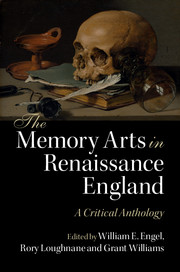Book contents
- Frontmatter
- Dedication
- Contents
- List of figures
- Acknowledgements
- A note on abbreviations
- Introduction
- PART I The art of memory
- Introduction to Part I
- I.1 Stephen Hawes, The Pastime of Pleasure (1509)
- I.2 [Laurence Andrewe], The Mirror of the World (1527)
- I.3 Peter of Ravenna, The Phoenix (1548)
- I.4 Guglielmo Gratarolo, The Castle of Memory (1562)
- I.5 Hugh Plat, The Jewel House of Art and Nature (1594)
- I.6 William Basse, A Help to Memory and Discourse (1620)
- I.7 John Willis, The Art of Memory (1621, 1661)
- I.8 Henry Herdson, Ars memoriae; the Art of Memory Made Plain (1651)
- I.9 Richard Saunders, Art of Memory (1671)
- I.10 Marius D'Assigny, The Art of Memory (1697)
- PART II Rhetoric and poetics
- PART III Education and science
- PART IV History and philosophy
- PART V Religion and devotion
- PART VI Literature
- Index
- References
I.7 - John Willis, The Art of Memory (1621, 1661)
from PART I - The art of memory
Published online by Cambridge University Press: 05 August 2016
- Frontmatter
- Dedication
- Contents
- List of figures
- Acknowledgements
- A note on abbreviations
- Introduction
- PART I The art of memory
- Introduction to Part I
- I.1 Stephen Hawes, The Pastime of Pleasure (1509)
- I.2 [Laurence Andrewe], The Mirror of the World (1527)
- I.3 Peter of Ravenna, The Phoenix (1548)
- I.4 Guglielmo Gratarolo, The Castle of Memory (1562)
- I.5 Hugh Plat, The Jewel House of Art and Nature (1594)
- I.6 William Basse, A Help to Memory and Discourse (1620)
- I.7 John Willis, The Art of Memory (1621, 1661)
- I.8 Henry Herdson, Ars memoriae; the Art of Memory Made Plain (1651)
- I.9 Richard Saunders, Art of Memory (1671)
- I.10 Marius D'Assigny, The Art of Memory (1697)
- PART II Rhetoric and poetics
- PART III Education and science
- PART IV History and philosophy
- PART V Religion and devotion
- PART VI Literature
- Index
- References
Summary
About the author
John Willis (d. 1625) developed a widely used system of shorthand writing and wrote extensively on applications of the memory arts.
About the text
The Art of Memory (1621) is a translation of the third part of Willis's Latin treatise, Mnemonica, sive reminiscendi ars (1618); a complete and augmented translation of the whole was produced by Leonard Sowersby (1661).
The arts of memory
This work is the most thoroughly developed English treatise on the memory arts that is not directly indebted to continental sources. Colloquial examples and contemporary references abound, such as tying a ribbon around one's finger as a visual reminder of something still to be done (A6r). Willis insists that memory theatres be constructed realistically in every detail to facilitate the effective staging and recall of ideas. Explicit references are made to emblems and imprese as viable components of memory theatres; and to this end Willis advocates keeping a commonplace book (enchiridion) for sorting and storing all such items under distinct headings.
Textual notes
John Willis, Mnemonica, or, The art of memory (London, 1661), A3r–A6v, B6r–B6v, E2v–F2v; the final excerpt follows The art of memory (London, 1621), C5r-v, for Willis's elaboration on this passage is not retained in later versions.
The Art of Memory
The Preface
First I acknowledge and willingly confess, that writing is the surest guardian of memorable things, far excelling all other art of memory; but a man cannot always commit to writing everything he desireth to remember, and must therefore necessarily sometimes make use of other helps as writing memorandums is worthily esteemed the best way of remembering; so that may rightly challenge the next place, which heareth greatest affinity thereto. Now if men deal impartially, they will easily find that the art of memory by places and ideas or images doth very nearly resemble writing. The places in artificial memory are, as it were, leaves; the ideas, letters; the distribution of them in places representeth writing; lastly, the repetition of them, reading, which thing Cicero in his Partitions, but more copiously in his second book De Oratore, doth elegantly declare.
- Type
- Chapter
- Information
- The Memory Arts in Renaissance EnglandA Critical Anthology, pp. 73 - 84Publisher: Cambridge University PressPrint publication year: 2016



